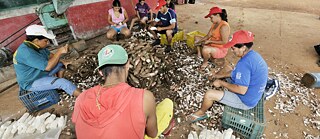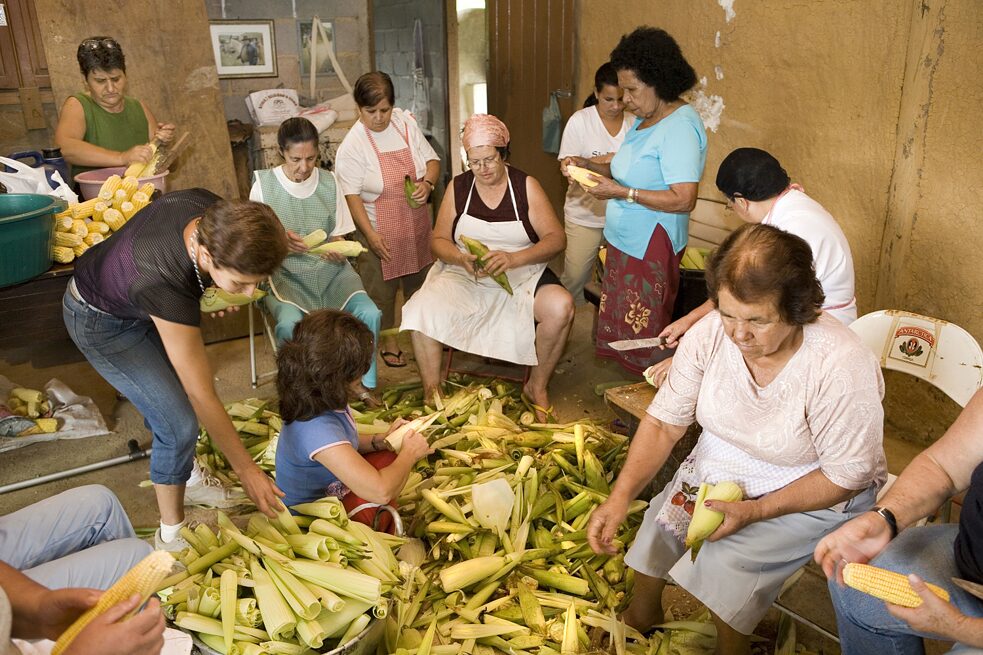A Denied Identity “The History of Cookery from the Perspective of the Colonial Rulers”

Manioc - the basis of Brazilian cuisine: Workers of the COOPAC cooperative peeling manioc roots (Manihot esculenta) for the production of manioc flour, settlement of the Brazilian landless movement Movimento dos Trabalhadores Rurais sem Terra, MST, Assentamento 14 de Agosto, Campo Verde, Mato Grosso State | Photo (detail): Florian Kopp © picture alliance / imageBROKER
The degree to which Indigenous peoples have influenced eating habits in Brazil today is being completely repudiated, says sociologist Carlos Alberto Dória, one of the best-known connoisseurs of Brazilian cuisine.
For Carlos Alberto Dória, the Indigenous influence on the diet of the ethnic classes in the Brazilian population is still visible today – mainly in the form of corn and cassava flour. “Amongst the elite, whose diet has always been Francophile, there are a few people who believe that foods made from corn or cassava flour are for ‘poor people’,” explains the sociologist, who has written books such as A formação da culinária brasileira – Escritos sobre a cozinha inzoneira (The origins of Brazilian cookery – literature about this intriguing cuisine), and is also director of the Centro de Cultura Culinária Câmara Cascudo. According to the specialist, it wasn’t just cookery from which the native population of Brazil was ‘eradicated’. Carlos Alberto Dória says: “It’s as observed by anthropologist Eduardo Viveiros de Castro: Brazil has turned Indigenous people into poor people. We have pushed the native populations into poverty, in every sense of the word,” concludes the sociologist.What role do the Indigenous groups play in the origins of Brazilian cookery?
A key fundamental role. But this is played down in the history of Brazilian cookery, because this story is told from the perspective of the colonial rulers. Archaeology shows that the modern indigenous groups in Brazil originated around 2500 years ago near Santarém in Pará state. They set out from that point and took possession of the whole country. One branch, which consisted of the Tupinambás, traversed the coastal regions and arrived at the point where Rio de Janeiro is now by about 800 AD. The Tupinambás cultivated cassava. Another branch, the Guaraní, advanced along the Andean cordillera and reached what is today the city of São Paulo by the year 1000 AD. The Guaraní planted maize (corn). Two completely different food cultures came into being, and Brazil's cookery developed on the basis of these two starchy flours.
Traditional cooking in the states of Minas Gerais and São Paulo, as well as the Central West region, is based on the maize from the Guaraní. Also we shouldn’t forget that corn flour was the basis on which the Portuguese conquered the Brazilian sertão territory. The Indigenous people went ahead to cultivate the maize on the expeditions into the interior of the country, which served as food to members of the explorer groups. As late as the 19th century there was a culinary tradition amongst the ethnic classes based on corn, cassava, beans, pumpkin and dried meat. That was the basis of Brazilian cuisine almost everywhere, apart from the Amazon region: they used a lot of fish and cassava there. It’s worth emphasising that we are talking about ethnic dishes here, because – like other places in the world – the food culture of the Brazilian elite was influenced by the French cuisine from the early decades of the 19th century.
Is it correct that the influence of the Indigenous peoples on Brazilian cookery is disappearing over the years?
Corn and cassava flour still play an important role in traditional ethnic Brazilian cookery. Once again, it’s important to emphasise: we’re talking about ethnic cuisine here. In the elite classes there are still a few who think that food made from corn or cassava flour are “poor people’s dishes”. But the native population of Brazil has not only been “eradicated” in terms of cookery. The greatest act of violence was when the Marquês de Pombal banned Nheengatu - the general Indigenous language of the Amazon region - from being taught in 1758, deeming it a “diabolical invention” by the Jesuits. As the anthropologist Eduardo Viveiros de Castro says, Brazil made the Indigenous people into poor people. We’re making the Indigenous people poorer in every sense of the word.
In your book “A formação da culinária brasileira – Escritos sobre a cozinha inzoneira” (The origins of Brazilian cookery – literature about this intriguing cuisine) you write that in “old São Paulo they used to sell Tanajura [fried ants] on baking sheets in the streets, and these were valued just as much by the poorer classes as by the ‘best families’. Later on, this latter group would only eat them in secret [...].”
Well, São Paulo has a gruesome past! They killed the Indigenous people in a matter-of-fact sort of way right up to the end of the 19th and at the beginning of the 20th century. The German zoologist Hermann von Ihering, who was the first director of the Museu Paulista from 1895 to 1916, wrote passages justifying the massacre of the Caingangue Indios. Recalling this relationship with the Indios is painful. The Caipira culture with its Indigenous roots was finally suppressed, although they were part of the tradition of the elite classes in the São Paulo sertão plains. I hardly need to mention that the French cuisine was all the rage in the society salons of the day.
Some Brazilian chefs have been using ingredients from Indigenous recipes in their own dishes for quite a while, such as ants. Might this be an indication that the reputation of Indigenous cookery in Brazil can be salvaged, or is this just a gastro fad?
Today we’re experiencing a turning point in which the Brazilian gastro industry is trying to recreate connections with the Indigenous ethnic groups. Around ten years ago for instance, culinary chefs and the press staked a fresh claim to the Amazon for themselves. But I think that as city dwellers in Brazil, we spend more time talking about tucupi (cassava juice) and tacacá (a soup made from that juice) than we do actually eating it. Gastronomy thrives on novelty, it’s a highly competition-driven environment, and chefs like to add certain weapons to their arsenal. At the moment the fashion is to use the ethnic repertoire as a resource, taking a few things from this world, for example taioba (leaves from the tannia plant) and ants, which have been around for centuries, and making themselves stand out from the others with the help of these “novelties”. These ingredients get elevated to gourmet status. But ultimately the urban elite don’t have the faintest idea how the ethnic classes of Brazil really eat.
This article first published on www.goethe.de/Brasilien.





0 0 Comments